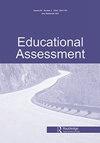新冠肺炎时期的评估:理解远程低采样测试期间学生脱离接触的模式
IF 2.3
Q1 EDUCATION & EDUCATIONAL RESEARCH
引用次数: 5
摘要
摘要新冠肺炎疫情的到来对K-12教育产生了深远影响。大多数学校过渡到远程教学,一些学校使用远程测试来评估学生的学习情况。然而,远程测试的控制不如学校测试,这引发了人们对参与测试的担忧。这项研究将2020年春季远程进行适应性中期评估的学生的脱离接触与2019年秋季在学校进行的评估的脱离接触进行了比较。结果显示,脱离接触在各个年级逐渐增加。这种模式在两种测试环境中没有显著差异,但美国印第安人/阿拉斯加原住民学生的结果除外,他们在远程测试中表现出更高的脱离感。此外,无论监考员与学生在同一个房间,还是远程监考,考试的参与功能都会自动暂停空闲学生的考试活动,并通知监考员,这一功能都会产生持续的积极影响。本文章由计算机程序翻译,如有差异,请以英文原文为准。
Assessment in the Time of COVID-19: Understanding Patterns of Student Disengagement during Remote Low-Stakes Testing
ABSTRACT The arrival of the COVID-19 pandemic had a profound effect on K-12 education. Most schools transitioned to remote instruction, and some used remote testing to assess student learning. Remote testing, however, is less controlled than in-school testing, leading to concerns regarding test-taking engagement. This study compared the disengagement of students remotely administered an adaptive interim assessment in spring 2020 with their disengagement on the assessment administered in-school during fall 2019. Results showed that disengagement gradually increased across grade level. This pattern was not meaningfully different between the two testing contexts, with the exception of results for American Indian/Alaska Native students, who showed higher disengagement under remote testing. In addition, the test’s engagement feature – which automatically paused the test event of a disengaged student and notified the test proctor – had a consistently positive impact whether the proctor was in the same room as the student or proctoring was done remotely.
求助全文
通过发布文献求助,成功后即可免费获取论文全文。
去求助
来源期刊

Educational Assessment
EDUCATION & EDUCATIONAL RESEARCH-
CiteScore
3.20
自引率
6.70%
发文量
24
期刊介绍:
Educational Assessment publishes original research and scholarship on the assessment of individuals, groups, and programs in educational settings. It includes theory, methodological approaches and empirical research in the appraisal of the learning and achievement of students and teachers, young children and adults, and novices and experts. The journal reports on current large-scale testing practices, discusses alternative approaches, presents scholarship on classroom assessment practices and includes assessment topics debated at the national level. It welcomes both conceptual and empirical pieces and encourages articles that provide a strong bridge between theory and/or empirical research and the implications for educational policy and/or practice.
 求助内容:
求助内容: 应助结果提醒方式:
应助结果提醒方式:


